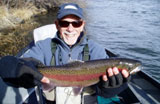Description
Ron English recently went to a fly tying
conclave in Idaho. While there he observed a
tyer using an unique yarn called “Disco
Yarn” to tie various flies. Ron thought it
would make a nice leech, so he tied some in
black and maroon. The bass loved the
results. Ron showed me the fly one afternoon
at Greenstone, and told me that the yarn is
available at
Wal-Mart.
Just what I need— more tying material!! So,
off I went to
Wal-Mart
on a search-and-buy mission. I found it
after receiving no help from
a befuddled-looking
clerk, and bought skeins of black and maroon
(about $4.00 apiece). There are many other
colors to choose from. My
great-great
grandkids will be tying with it—that’s how
much there is in a skein.
I threw it into my tying bag for my Fall
River trip, just for giggles. While there I
had good luck on large fish using a fly
called “Bloody Black Leech”, tied with
STS Trilobal
Dubbing in the bloody-black color. After
losing the last of the leeches, I discovered
I didn’t bring the STS dubbing. The Disco
Yarn caught my eye and the wheels began to
turn. What I ended up doing was twisting a
black and a maroon piece together to
intermix the colors. The result looked good
— and it actually performed on trout and
fished deeply for me and several others in
our group. So, let’s tie this extremely
simple fly since there are still a lot of
spring bass to be caught.
Tying Instructions
|
|
1. Smash the hook barb. Place the
cone onto the hook, place the hook
in the vise, and wrap 4 or 5 turns
of lead or substitute on the shank.
Push it up directly behind the cone;
this will hold the cone in place.
2. Secure the lead in place with
thread wraps and then wrap back to
the end of the shank, just above the
back of the now-smashed barb. |

|
|
|
|
|
3. At that same point, tie in strips
of black and maroon Disco Yarn.
Twist them together by weaving one
around the other until you have a
woven strip about 5” long. Using a
dubbing comb or brush, gently brush
the yarn downward to pull free any
of the yarn that was caught in the
twisting process. Move the thread
forward to behind the cone. |
 |
|
|
|
|
4. Grab the ends of the yarn with a
hackle plier and wrap forward to the
cone, being careful not to place too
many winds on the hook. It is best
to tie leeches sparsely so they
present a sleek profile. Leeches
don’t look fat while they are
swimming.
5. Tie the yarn
off behind the cone and whip finish. Simple, eh? |
 |
|
|
|
|
Useful
Tips for Fishing Leeches
|
|
|
|
|
1. In lakes it’s best to use an
intermediate line to keep the leech
high in the water column.
2. Your strips should be short
and slow. If you have watched leeches swim, they generally don’t move fast;
movement is achieved by contractions of the body, which then stretches out.
|
|
|
|
|
Tying
Tips
1. When tying with any soft
material with long “barbules,”
such as soft bugger-type hackle
or yarns such as Disco Yarn,
sweep the material backward as
you move toward the front of the
fly.
2. Keep things as sparse as
the pattern and/or its intended use will permit. I am a firm believer in “less
is more” in this regard.
3. When putting beads or cones
on hooks, place the hook in the vise so that the jaws grab the shank and the
bend is down. This puts the point in a vertical position. Then, using a good
pair of tying tweezers, pick up a bead or cone and slip it onto the hook, all
the while holding your other hand under the hook to catch the bead or cone if
you drop it.
You are going to like how
Disco Yarn flies move in the water. When the fly is stripped, the material lays
flat against the shank; when it pauses, the material splays out enticingly. With
the cone and weight, it also dips and rises with the retrieve. |
|
|
|
|
 |
|

